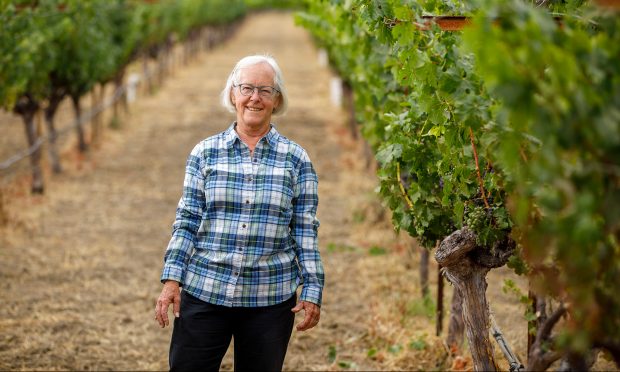
Cathy Corison ’75, standing in her vineyard along Napa Valley’s St. Helena Highway, started making cabernet sauvignon before she had a vineyard or a winery of her own. Photography by Robert Durell
In a vineyard in full green flourish under a bright blue sky, Cathy Corison ’75 is caressing a cluster of grapes.
She’s showing off a little. Corison’s small winery and vineyard are tucked in among much bigger names along St. Helena Highway, the tree-lined central axis around which Northern California vino revolves. But these little green grapes, a few weeks away from ripening and harvest beginning in mid-September, are hers. They’re the beating heart of Corison’s if-you-know-you-know cult-fave cabernet sauvignon. And she takes very good care of them.
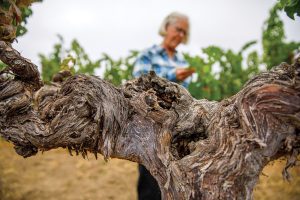
The vines in one of the Corison Winery vineyards are five decades old. “I so value these gnarly old ladies,” says Cathy Corison ’75. “It’s like a sculpture garden.” Photography by Robert Durell
The grape clusters hang from thick, twisted trunks, gray as driftwood, that seem to reach toward each other all along their martial ranks. The vines are five decades old, ancient by Napa standards. “I so value these gnarly old ladies,” Corison says, pushing a leaf aside. “It’s like a sculpture garden.”
Except it’s all alive, of course. A stalwart Napa winemaker, Corison is well known for spending a lot of time out among her vines. She works with simple parameters—loamy soil that holds the rain, so Corison barely needs to irrigate, and the Napa Valley climate, which is optimum for growing world-class cabernet sauvignon: hot days, cold nights. “We work hard to get the right amount of air and light in to the fruit for color and flavor development,” she says.
Corison makes artful, classic Napa cabs—lower in alcohol with brighter flavors and what the language of connoisseurship calls “structure,” an elegant and well-defined progression of aromas and flavors. But there is fashion in winemaking like anything else, and those kinds of wines went out of style in the late 1980s. The last few years at Corison Winery have been better, the awards and accolades (and sales) a vindication for her approach. But that was never a sure thing. Corison has always been an outlier.
“When I started this project, this wine was fully formed in my head. Power and elegance. Cabernet is always powerful, but is far more interesting to me at the intersection of elegance,” she says. “Good wine can be made by a committee. Great wine cannot. It reflects the hand of the maker.”
At Pomona, Corison was a competitive springboard diver. The school didn’t have a women’s team, so she joined the men’s team—lettered in the sport, even. Part of her training was tumbling on a trampoline, so when the opportunity came up for people in the campus community to teach short noncredit classes, she volunteered to instruct other Sagehens on how to take those big, bouncing leaps.
At the sign-up fair, at the table adjacent to Corison’s, a young professor was offering a wine appreciation class. This was John Haeger, an expert in the Sung Dynasty with a serious wine collecting hobby. (Today Haeger is a big-deal writer on the subject.) Corison was just 19, but beer and wine flowed more freely on campus back then. On a whim, she signed up.
The tastings were on Sundays at Haeger’s house. All the wines were French and delicious, and the classes were fun. For Corison, though, they were more than that. The agronomy of grapevines, sugar transformed by yeast into alcohol, the chemistry of wine production, the flavor of wood from barrels…she was hooked. “What really grabbed me is that wine is a collaboration among a whole series of living systems; the result is the alchemy that is wine,” Corison says.
She graduated with a biology degree, and two days after graduation, she went to Napa. This was almost 50 years ago; there were just 30 wineries in Napa then, but some of them were starting to make genuinely great wine—from now-iconic vintners like Robert Mondavi and Donn Chappellet ’54, himself a Pomona grad.
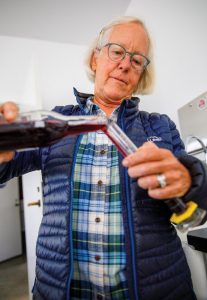
Cathy Corison ’75 earned a master’s degree in enology at UC Davis, where she also studied viticulture. Photography by Robert Durell
Then, a year after Corison showed up in Napa, Napa showed up in France. At a now-famous tasting at Le Grand Hôtel in Paris (today it’s the InterContinental Paris le Grand), nine big-shot sommeliers and restaurateurs judged—blind, meaning no one knew which glass held which wine—Napa chardonnays versus French white Burgundies, and Napa cabernet sauvignons versus cab-dominated red blends from Bordeaux. The results were all over the map, statistically and literally, but the boozy score at the end of the night was as undeniable as a hangover: The Californians—sacrée merde!—won. And a reporter from Time magazine was there to file the news. What came to be known as the Judgment of Paris made Napa into a world-class wine producer, and Corison was in the thick of it. “It was blind luck, but it catapulted the Napa Valley onto the world stage,” she says.
Corison started a master’s program at UC Davis, taking classes in both winemaking and the care of grapevines—enology and viticulture—still considered somewhat separate realms even today. And she started working at wineries, even though women were scarce in winemaking back then. She ended up heading the winery for Chappellet Vineyard. “She had both academic knowledge and also knowledge from working at Freemark Abbey and Yverdon, a lot of real-world experience,” says Phillip Corallo-Titus, one of Corison’s assistants at Chappellet’s winery and, today, the head winemaker there. “She just knew a lot about winemaking that I didn’t know, and she hadn’t been in the industry that much longer.”
She knew enough, in fact, to start making her own wine. In 1987, toward the end of her tenure at Chappellet, she began to buy grapes and barrels and make her own cabernet sauvignon as a custom client in other people’s wineries. Her brand was launched.
On the last day of 1995, Corison and her husband William Martin closed a deal on a broken-down Victorian house and an old vineyard that had been on the market for eight years. Both were fixer-uppers. The Victorian needed a new foundation, new wiring, new plumbing and a coat of paint. And the vineyard needed a lot of TLC. This is where they built a barn in 1999 to serve as the winery.
Corison had been told the old rootstock was a variety susceptible to phylloxera, the vine-killing bug that nearly crushed Napa in the 1980s. But it turned out to be the phylloxera-resistant strain St. George. “We had bought this for bare-land prices,” she says. “It was a miracle.”
With those old, badass vines, Corison had a vineyard of her own at last. After more than a decade of making wines under her label with other people’s grapes in other people’s wineries, she could keep making the classic Napa cab she’d learned to make in the 1970s—lean, balanced and complex—with the fruit of her own Kronos Vineyard. In 2015, she and Martin added the nearby Sunbasket Vineyard to their estate.
From the start, Corison harvested grapes weeks before many other winemakers. These early grapes’ lower sugar levels result in wines of lower alcohol, because the yeast converts the sugar to alcohol. “The grapes come into the winery with complex flavors, tannins that feel like velvet, and snappy acidity,” she says. “In a good year, farmed right, I can have all the flavors good cabernet produces, from cherries to plum to cassis to blackberry. By picking early, I preserve that bright red and blue end of the flavor spectrum. With time in the bottle, this turns into the floral perfume I so value.”

Winemakers make use of scientific analysis, sending samples to labs to test for qualities such as total acidity, pH, alcohol and sugar levels and to check for microbiological stability once in barrels. Photography by Robert Durell
But that wasn’t what Napa was making by then. The moneymakers were sweet, juicy sugar bombs with 15% alcohol or more. Some people like those—no judgment. Well, OK, a little judgment. More seriously, that style might have been popular not for its own qualities, but because of the idiosyncratic recommendations of influential wine writers like Robert Parker. “In the ’90s, the Robert Parker era, Napa maybe took it too far,” says Jess Lander, wine reporter at the San Francisco Chronicle. “Big, concentrated fruit bombs, lots of oak, lots of structure and tannin. That’s what made Napa famous, I would say.”
So by the early 2000s, things were tight for Corison Winery. Corison’s neighbors were building multimillion-dollar visitor centers and tasting rooms, hosting tour groups, selling swag. Napa was changing; Corison wasn’t. She thought she might have to sell.
“I’ve never met anybody so unwavering on their ideas,” Corallo-Titus says. “She stuck to a philosophy when maybe, at times, during the ’90s and 2000s, the industry was going in another direction.”
Maybe there’s a hint of critique in all the compliments about Corison’s unwavering faith. Either she’s as indomitable as her tough old vines or just too stubborn to survive in the modern Napa. She could have made wine that tasted like anything she wanted. Why not just make something people wanted to drink?
“All we have to sell is our integrity,” she says. “I just couldn’t make a wine I didn’t believe in.”
The thing about pendulums is that they swing back. “I’m hearing a lot of winemakers talk about acid and freshness and using less oak,” Lander says. “Cathy’s been doing that all along, and people are starting to realize that’s what they want to drink.”
What happened? Well, the sugar bombs of the 2000s aged poorly, Lander says. And wine criticism welcomed lots of new voices, especially on social media. Young, hip sommeliers started evangelizing Corison’s wine, too.
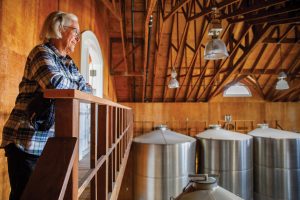
Cathy Corison ’75 and her husband built a new barn in 1999 to serve as the winery, which includes the large stainless steel tanks where fermentation occurs. Photography by Robert Durell
Corison herself isn’t sure what flipped the switch, but she definitely noticed. The New York Times started touting her in the 2010s. The Chronicle named her winemaker of the year in 2011. She got a couple of prestigious James Beard Award nominations. “That took 35 years,” Corison says. “It took 25 years for the business to be a going concern. It’s only been in the last 10 or 12 years we’ve been comfortable enough not to be terrified all the time.”
Napa might have changed again, but her wine hasn’t. The best answer to the question of how Corison turned things around comes while I sit across from her amid stacks of empty barrels, an array of quarter-full wine glasses on the table between us. Getting to taste wine with a winemaker is like visiting with an artist in their studio. She’s talking me through vintages from the 2010s forward, including a sip of the as-yet-unreleased 2020. That was a difficult year for Napa, when climate change-powered wildfires meant lots of vineyards’ grapes were tainted by smoke. Not Corison’s: Her earlier harvest meant she’d already brought in her grapes.
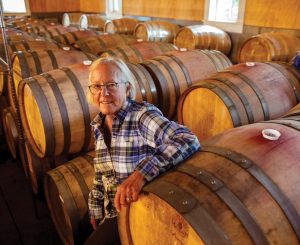
After starting her career at a time when women winemakers were still rare in Napa Valley, Cathy Corison ’75 was the San Francisco Chronicle’s winemaker of the year in 2011. Photography by Robert Durell
I also get a bit of her cabernet sauvignon from 1999, when the winery we’re sitting in was new. It’s extraordinary—the older wine is inky, with the same tart red-fruit-eau-de-vie lattice as the more recent bottles, but with an umami taste. And the ’20 has it too. It’s like time travel. What must have seemed like stubbornness tastes like continuity today. Corison’s wine is a big deal for the simple reason that it’s good.
It also, not incidentally, takes me back to the Napa reds my dad drank when I was a kid. I tell Corison this, and she smiles. That’s all she wants from her wine. “I want it to grace the table,” she says. “I want it to have a long and interesting life.” Take care of the grapes, and eventually they’ll take care of you.
